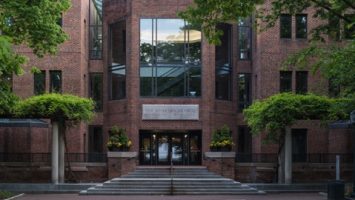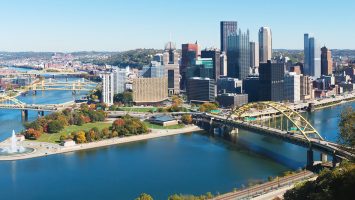
Denver: mile high city, home of the Broncos (and six other professional sports teams), smart city. The city isn’t just progressive; it has the living lab to back it up. TWO, to be exact. Denver also won two Smart 50 Awards this year, placing them in an elite group of project leaders around the world to implement innovative and influential smart cities work this year. I had the opportunity to interview Emily Silverman, Program Manager for Denver Smart City, about the living lab on Federal Boulevard and what it means to be “smart”. Check it out!
LB: Denver is THE place to be if you’re interested in seeing smart projects up close. Tell us about this one, in particular, and how it became a priority for Denver.
ES: The City and County of Denver has multiple living labs where we test innovative ideas and technologies to understand capabilities and limitations before large-scale deployments. One of our living labs is located on Federal Boulevard, which is one of our most dangerous city roads, with a rate of fatalities that is 20 times higher than the urban rate on other Colorado roadways. In addition, Federal Boulevard runs through many of our under-served neighborhoods that are disproportionately affected by poor air quality and increased asthma rates among Denver’s children. Our goal with the living lab on Federal Boulevard is to enhance mobility, improve safety, and minimize adverse environmental impact. For example, there are a significant number of pedestrian-vehicle collisions and, through studying the data, we hope to develop technology that detects the presence of someone in the street and have the vehicle respond accordingly.
LB: What partners did you work with to make the project a success, and how did you vet/validate them?
ES: A team formed to pursue an innovative procurement approach that will give all city agencies and departments access to the most diverse, agile, and uniquely capable “smart city” firms through a single RFP. This process allows Denver to take in a variety of proposals, from small to large firms, across the nation. Through the city’s department of general services, we were able to vet and validate the legitimacy of these potential partners before choosing a large pool we will be able to pull from for future smart city projects.
With all technology projects, the best thing to do is to dig in, start small, and learn as much as possible with our partners as collaborators. We now can experiment with our data, making exciting discoveries while being highly innovative. With help from Microsoft, we’ve achieved all of this in just a short period. We have done past work with them, and our system is supported by the Microsoft Data Lake and IoT Hub.
We were happy to discover that the Federal Highway Administration (FHWA) and the US Department of Transportation (USDOT) Intelligent Transportation Systems Joint Program Office (ITS JPO) had experts available to help our team adopt agile development practices.
Kevin Coyne, Vice President of Advanced Services at West, has provided amazing technical support himself and with his team from West to advance our efforts. West was a part of an initial team put together to support Denver’s application for the USDOT Smart Cities Challenge in 2016.
LB: What was the biggest obstacle in bringing the project to fruition?
ES: We are aligning our effort with the federal work at every step. To ensure interoperability and success, we are building on the amazing work at the federal level with the V2X Hub, an open-source tool available at connectedvcs.com. It provides a platform for public and private partners to work together on applications that improve congestion and safety outcomes. The V2X Hub is a Rosetta stone for the connected vehicle system. The timing of their work with our work on Federal Boulevard is challenging but will be very rewarding to ensure a system that works, is interoperable and can be scaled city-wide.
LB: What did you learn along the way that you wish you knew at the beginning? How would it have changed the outcome?
ES: Denver did not have a clear understanding of the technology readiness of the items needed to make this effort successful. Now that we know exactly where the federal efforts are, as well as the efforts of the vendors whose goods we are using, I believe technology readiness may affect the timing of implementation but will not change the outcome, since we are committed working toward improving congestion, safety and air quality in Denver.
We don’t get to start from scratch in Denver, because we already have many important pieces of technology and infrastructure on our roads today, from fiber and signals to the items that ensure the system works such as traffic signal controllers and MMUs. We must work within the preexisting infrastructure of Denver, which will ensure interoperability and continued service of our infrastructure. I don’t think we fully understood how hard it would be to get this cutting edge technology to work within our legacy software. We found, especially early on, that the technology we were testing just wasn’t ready for the complexity of Denver’s existing technology infrastructure.
LB: You received funding from the city’s Innovation Fund. Tell us more about that and the process the city has for growing the fund, as well as your process for extracting support.
ES: iFund is a governance board composed of citywide business leaders appointed by the Mayor to improve City of Denver operations and service delivery by investing in breakthrough and continual improvement programs and projects. Funding decisions are made based on project objectives, definition, resource requirements, return on investment, and assumptions and risks. iFund members then used these pre-determined criteria to score the business cases presented by agency requestors. Once all scores are compiled, members deliberate and reach a consensus on which projects will be funded for the following year.
Since its inception, the Innovation Fund has supported a wide array of projects, including implementing an integrated criminal justice (ICJ) system; replacing citywide enterprise systems, such as new HR, finance, procurement and budgeting systems; creating the Peak Academy; and facilitating other projects to improve transparency, accountability and data integrity throughout the city. In 2019, the city budgeted $8,000,000 for iFund projects.
LB: How do you know that the sensors and other tech are the right ones? What trusted advisors or experts did you lean on to ensure you were selecting the most appropriate solution providers for your needs?
ES: We worked closely with FHWA’s Turner-Fairbank Highway Research Center Borrowing (TFHRC). The TFHRC’s Saxton Transportation Operations Laboratory works with a contractor to offer Connected and Automated Vehicle support services, which includes an online interface at www.connectedvcs.com. Denver’s technical team collaborated with the support staff to get all the loaner equipment working with the city’s traffic signal controllers, including older generation controllers Denver’s team had assumed would not be supported. This achievement was a big deal for Denver. Our smart city team operates from a set of core values, including supporting multi-vendor interoperability and avoiding lock-in.
LB: What’s next for Denver? What other priorities are bubbling up?
ES: Allowing First Responders, public transport, and snow plow priority on the roads: Denver is deploying technology that allows traffic signals to communicate with emergency vehicles, snow plows and public transit buses, so that they reach their destination faster, more efficiently and safer.
Electrifying Vehicles: Denver is expanding the availability of charging stations across the city, both at its properties and to serve ride share drivers. These stations — many will be installed this year — will increase the number of electric vehicles in the city and reduce emissions.
Our 2019 RFP for smart city program management received an unprecedented 160 respondents in January, 21% of which were women or minority-owned businesses. It has been acknowledging as an innovative procurement process reducing the barriers to entry, enabling true collaboration between government and the private sector.
Creating a two-year action plan: A multi-departmental effort is underway to identify a strategic path forward for Denver smart cities and identify near term priorities to further strengthen Denver’s program.
LB: What does it mean to you to win a Smart 50 Award?
ES: We are honored to win this award, which recognizes the hard work the team has done on behalf of those who live, work and play in Denver. We are excited to highlight our progressive approach to innovation, which is rooted in Denver’s pioneering, western spirit. We believe this award confirms we are on the right path, working to contribute to emerging industry and looking to deliver value directly to our residents.


